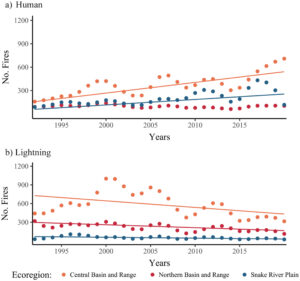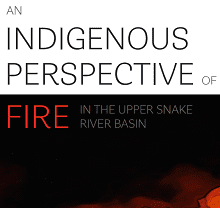Feature
View article.
View story map.
This study estimates how fire regimes have changed in the major Great Basin vegetation types over the past 60 years with comparisons to historical (pre-1900) fire regimes. We explore potential drivers of fire regime changes using existing spatial data and analysis. Across vegetation types, wildfires were larger and more frequent in the contemporary period (1991–2020) than in the recent past (1961–1990). Contemporary fires were more frequent than historical in two of three ecoregions for the most widespread vegetation type, basin and Wyoming big sagebrush. Increases in fire frequency also occurred in saltbush, greasewood, and blackbrush shrublands, although current fire return intervals remain on the order of centuries. Persistent juniper and pinyon pine woodlands burned more frequently in contemporary times than in historical times. Fire frequency was relatively unchanged in mixed dwarf sagebrush shrublands, suggesting they remain fuel-limited. Results suggest that quaking aspen woodlands may be burning less frequently now than historically, but more frequently in the contemporary period than in the recent past. We found that increased fire occurrence in the Great Basin is associated with increased abundance and extent of nonnative annual grasses and areas with high concentrations of anthropogenic ignitions. Findings support the need for continuing efforts to reduce fire occurrences in Great Basin plant communities experiencing excess fire and to implement treatments in communities experiencing fire deficits. Results underscore the importance of anthropogenic ignitions and discuss more targeted education and prevention efforts. Knowledge about signals of fire regime changes across the region can support effective deployment of resources to protect or restore plant communities and human values.
View booklet.
The reciprocal nature of our human interactions with our natural environment can be viewed through the lens of fire management in the West by federal, state, and private land managers. A wildfire’s impact is not affected by the presence of a geopolitical boundary, it is still inherently a natural process fueled by relatively well-understood dynamics. Yet, changing climate conditions such as extended heat waves, droughts, shifts in rainfall patterns or types of precipitation are changing how fire behaves in the West. From a Tribal member’s perspective, these climatic conditions, social development, and ecological degradation are all connected events with relatively predictable consequences. Because there is a reciprocal relationship with our environment, we are collectively accountable for the consequences of our choices in a modern context through a changing climate.
The Western Forbs: Biology, Ecology, and Use in Restoration project is now a website.
Westernforbs.org is designed to aid seed collectors, seed growers, nurserymen, landowners, restoration practitioners, and land managers as they increase the supply and use of native forbs.
- Species menu tab – Offers complete reviews that synthesize existing research and practical experience available for western forb species. Anything reported on the biology, ecology, seed technology, and use in wildland restoration is included.
- Lookup Table menu tab – Summarizes forb species data in a searchable and filterable table. Included are the data on taxonomy, distribution, biology, ecology, seed supply development, and nursery and wildland restoration knowledge for each species.




